The numbering system used below chronologically divides the medals into the seven major types, based on the different forms of the Royal arms. Stylistic variations in design form the subtypes. It is hoped that this method of cataloging will make it relatively easy to incorporate new designs if and when they surface.
The estimated numbers are derived from a survey of the index of brokers’ bonds held by the London Metropolitan Archives. No central list of brokers and, more importantly for this purpose, no central list of when they were sworn, exists. The various regulations and statutes over the years required that lists be regularly posted in London, but not enough of these survive to be of much help. The Court of Aldermen records indicate when a broker was approved, but those records are of limited help because an approved broker did not always follow through and post a bond and obtain a medal. Thus, a survey of those brokers who actually posted bonds will be reliable to judge the relative rarity of the various types of medals. Finally, the estimates exclude bronze examples.
The numbers stated below also assume that a new design was introduced promptly in the same year that the Royal arms changed.
What follows is a list of the types and varieties of medals that have been identified by date. Where possible, information regarding the medal’s design, method of manufacture and maker are identified.
Type 1 (1697 – 1702)
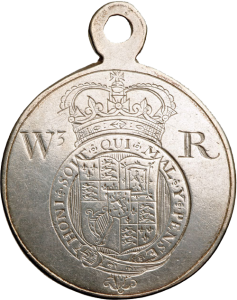
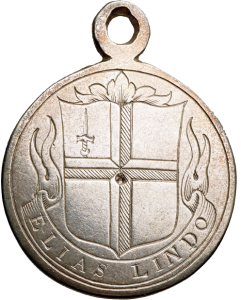
Type 1 (1697 – 1702): Silver; Diameter: 39 mm, Thickness: 2 mm; weight: 31.11 grams; medal die rotation (↑↑). Cast flan with engraved designs and integral suspension loop. Obverse: Royal arms of William III used from 1697 to 1702, surrounded by the Garter for The Most Noble Order of the Garter, surmounted by a crown, with the legend “W3” on the left and “R” on the right. Reverse: Arms of the Corporation of London, over a scroll containing the owner’s name. The maker is unknown, but is possibly Sir Francis Child or one of his colleagues.
This is the first medal issued under the 1697 Act. The only known, existing example belonged to Elias Lindo, one of the brokers originally sworn in 1697, and is currently in the collection of the Museum of London. This medal is particularly rare because not only is it one of the first issued, but Elias Lindo was one of the first twelve Jewish Brokers to be admitted. The descendants of Elias Lindo donated this example to the Museum of London in 1931.
Maker: Unknown.
Approximately 90 examples were produced.
The picture of the Lindo medal is © The Museum of London and used with permission
Type 2 (1702 -1707)
Type 2 (1702 -1707): Anne was crowned in 1702, and until 1707, she used the Stuart royal arms that were previously used by Kings James I, James II, Charles I and Charles II. Anne also elected to use the motto “Semper Eadem” (Always The Same), which was a departure from the motto used by William III, “Dieu Et Mon Droit” (God And My Right).
Presumably, the design of the medals changed to reflect this change of the Royal arms. Unfortunately, no medals depicting Royal arms used by Anne during this period are currently known to exist. Therefore, it is unclear whether any such medals actually exist.
It is not surprising that there are no known examples – only about 22 brokers were admitted between 1702 and 1707, making these medals the rarest of the series, assuming they ever existed in the first place.
Maker: Unknown.
Approximately 22 would have been produced.
Type 3 (1707 – 1714)
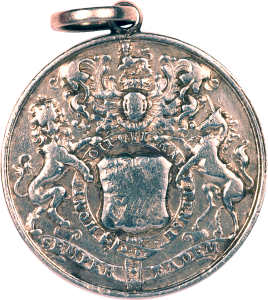
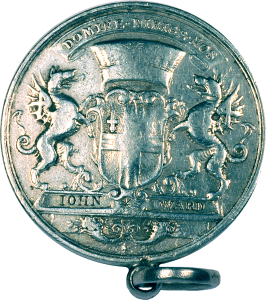
Type 3 (1707 – 1714): Silver; Diameter: 40 mm; Thickness: 2 mm; Weight: 25.9 grams; Coin die rotation (↑↓). Cast. Obverse: Full achievement of Royal arms used by Anne between 1707 and 1714; the following motto in a scroll: “SEMPER EADEM” (Always The Same). Reverse: Full achievement of arms of the Corporation of London, over a blank space for the broker’s name and crossed cornucopia; above, the Lord Mayor’s fur cap and the following motto in a scroll: “DOMINE DIRIGE NOS” (Lord Lead Us).The Royal arms used by Anne changed in 1707 to reflect the Union with Scotland, which took effect on May 1, 1707. This form of the Royal arms was used until the accession of George I in 1714.1707 also marks an important year in the development of the medals. The original 1697 Act lapsed, and Parliament did not renew it. Instead, parliament enacted completely new legislation that had one significant change: the number of admitted brokers was no longer restricted to 100. However, the Court of Aldermen continued to limit the number of Jewish Brokers to twelve and required all brokers to carry a silver medal. Brokers previously admitted under the 1697 Act had to take another oath under the bond. They did not, however, r1707 Act and provide a new eceive new medals.
Maker: Unknown.
Approximately 245 were produced.
Type 4a (1714 – approximately 1770)
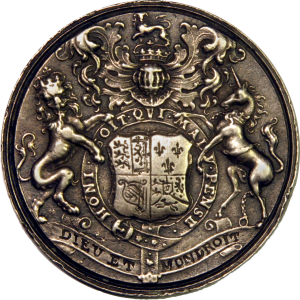
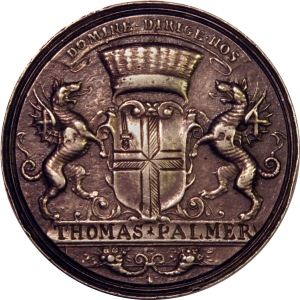
Type 4a (1714 – approximately 1770): Silver; Diameter: 40 mm, Thickness: 2 mm; Weight: 25.9 grams; Medal and coin die rotation (↑↑ and ↑↓). Cast and engraved. Obverse: Full achievement of the Royal arms used between 1714 and 1800 with central arms engraved; the following motto engraved in a scroll: “DIEU ET MON DROIT” (God And My Right). Reverse: The same as Type 3, but the central arms are engraved. Cast and chased. The maker is unknown.With the ascension of George I in 1714, the Royal arms changed to include design elements indicating his position as the Elector of Hanover. This was achieved by placing the arms of the Elector of Hanover in the fourth or lower right corner of the Royal arms. This version of the Royal arms spanned the reigns of George I, George II, and the first 39 years of the reign of George III.Unlike the previous medals, these were cast, but the central space of both sides, for the Royal arms on the obverse and the arms of the Corporation of London on the reverse, were blank and engraved by hand.
There is no documentary evidence explaining why the manufacture of the medals changed from a fully cast design to cast and engraved designed. On all observed examples, the engraving is quite crude, even by the standards of the day. Given their simlarity, they could have been remianing stocks of Type 3 that were altered to depict the new arms and motto. Sometime between 1760 and 1770, cast and chased medals gave way to fully struck medals.
Maker: Unknown.
Approximately 990 were produced.
Type 4b (approximately 1760 – 1800)
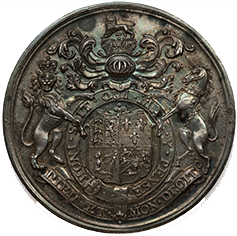
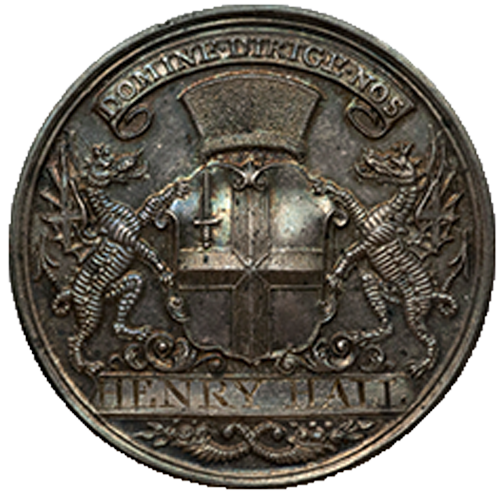
Type 4b (approximately 1760 – 1800): Silver; Diameter: 40 mm, Thickness: 2 mm; Weight: 25.9 grams; Medal and coin die rotation observed (↑↑and ↑↓). Struck. Obverse: same as Type 4a. Reverse: same as Type 4a. The only difference is that the entire medal and design are struck. The only engraved portion is the owner’s name.
The change from cast to engraved medals occurred sometime between 1760 and 1770. Both types 4a and 4b appear for brokers sworn from 1760 to 1770. No documentary records exist indicating exactly when or why the change occurred. Medals of both types for brokers admitted between 1760 and 1770 exist.
A bronze example of this medal is at The British Museum, and it is presumed to be a trial or specimen strike. The medals weighs 26.52 grams, and is 3 mm thick, slightly thicker than the regular silver medals. The bronze example was originally part of the Sarah Sophia Banks collection, and was presented to The British Museum in 1818.
January 2020: Within the last year, two people have told me that they have examples of Type 4b which are named, silver plated bronze. I have not seen these in person. While at least one, unnamed bronze example exists, I tend to doubt that there are named, silver plated bronze examples out there. I doubt that any plating would be contemporary as Sheffield Plate could not be performed on these medals (at least as I understand the process) and other plating methods were not developed until much later. That leaves only the possibility that a bronze trial piece was plated and named at a much later date, which seems unlikely. Also, plating a bronze medal would seem to contrary to the statutes and regulations that specifically called for silver medals. In any event, we will see if any others like this turn up.
Maker: Unknown.
Approximately 1,625 were produced.
Type 5 (1801 – 1815)
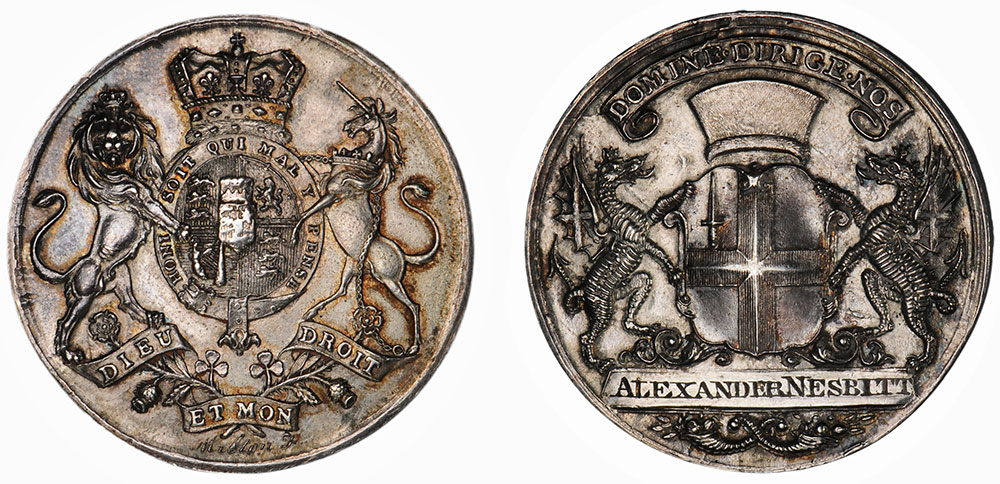
Type 5 (1801 – 1815): Silver; Diameter: 40 mm, Thickness: 2 mm; Medal die rotation (↑↑). Struck. Obverse: Full achievement of the Royal arms of George III used between 1801 to 1815. Reverse: The same as Type 3.
The maker is John Milton, and the medals are signed “Milton F” in cursive lettering on the obverse. These medals are fairly crudely made, particularly when compared to other medals that Milton produced. This medal is frequently encountered in auctions and dealers’ stocks. Examples with clear, sharp Milton signatures are extremely scarce.
The Royal arms changed again in 1801 to reflect the union with Ireland, which became effective on January 1, 1801. The arms of the Elector of Hanover were moved from the fourth or lower right corner to the center of the Royal arms. The arms of Hanover were surmounted by the Electoral Cap of Hanover.
The British Museum has a bronze example, which is presumed to be a specimen or trial strike. That example is struck on a thick flan, 4 mm, and weighs 46.50 grams. The British Museum purchased it from Edward Hawkins in 1860.
Maker: John Milton.
Approximately 1,200 were produced. Modern reproductions in cast pewter exist.
Type 6a (1816 – 1837)
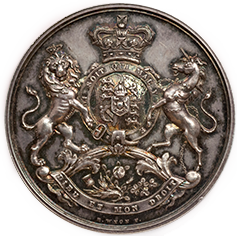
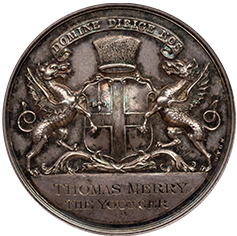
Type 6a (1816 – 1837): Silver; Diameter: 40 mm, Thickness: 2 mm; Weight: 25.9 grams; Medal die rotation (↑↑). Struck. Obverse: Full achievement of the Royal arms of George III, George IV and William IV, as used between 1816 and 1837. Reverse: The same as Type 3, except the crossed cornucopia are omitted.
The maker is Benjamin Wyon. Wyon’s name appears on both the obverse and reverse.
The Royal arms changed subtly in 1816, when the Electoral Cap was replaced with the royal crown of the Kingdom of Hanover. The change was due to Napoleon’s abolition of the Holy Roman Empire and the system of electoral princes, and the Congress of Vienna’s designation of Hanover as a Kingdom.
Maker: Benjamin Wyon.
Approximately 1,200 were produced.
Type 6b (1830’s)
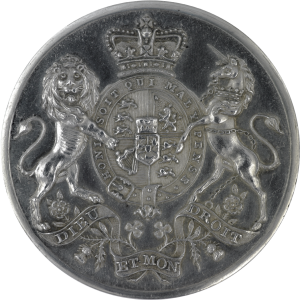
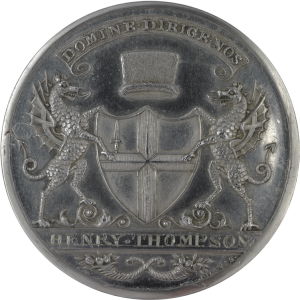
Type 6b (1830’s): Silver; Diameter: 40 mm, Thickness: 2 mm; medal die rotation (↑↑). Struck. Obverse: Same as 6a. Reverse: Same as 3. While the overall design is the same as Type 6a, Type 6b contains various stylistic changes. The most notable change from Type 6a is that the arms of the Corporation of London is more spade-shaped than in previous designs. This type is signed “J • DAVIS •” on the reverse, and is attributed to Joseph Davis.
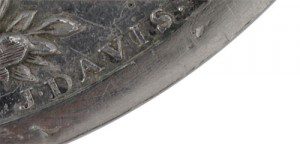
Davis’ name along the 5:00 position on the reverse.The reason for the change and the exact dates of usage are unknown. Some have suggested that this design was prepared but never used. At least two issued examples, both dating from the 1830’s, are known to exist. It is unknown whether this design was issued concurrently with Type 6a, or whether it completely replaced Type 6a. Examples of Types 6a and 6b date from the same time period, suggesting they were issued concurrently.
The attribution to Joseph Davis is also questionable. Some sources state that Joseph Davis lived and worked in Birmingham and never cut his own dies. Supposedly, Davis struck and signed medals from dies prepared by others. It seems odd that while Benjamin Wyon was producing medals, the Court of Aldermen would commission a new design from Davis, who was working in Birmingham, and who did not cut his own dies. In any event, there is currently no explanation for the Davis medals.
Assuming that Type 6b was used exclusively from at least 1832 through 1837, an estimated 220 were produced.
The picture of the Thompson medal is © the Museum of London and used with permission.
Type 7 (1837 – 1886)
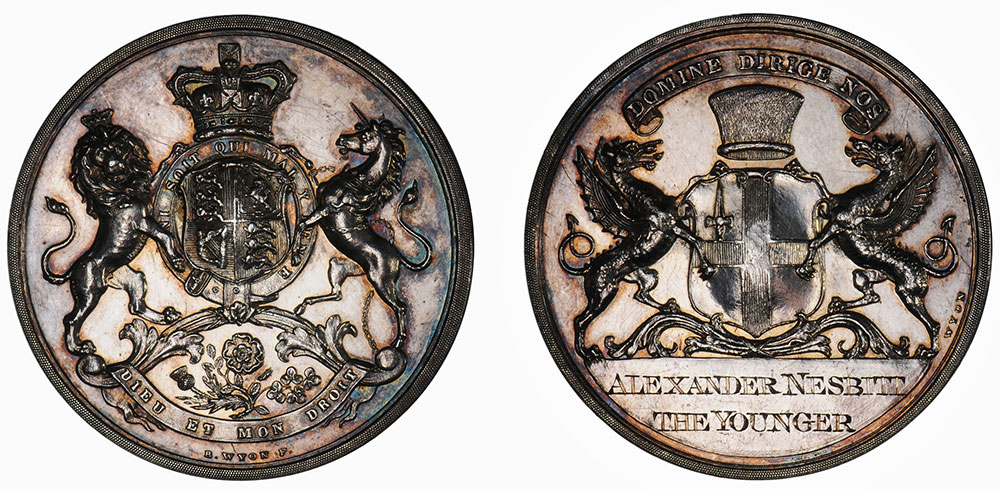
Type 7 (1837 – 1886): Silver; Diameter: 40 mm, Thickness: 2 mm; medal die rotation (↑↑). Struck. Obverse: Full achievement of the Royal arms used by Victoria from 1837 to 1901. Reverse: The same as Type 6a. The maker is Benjamin Wyon. “B. WYON F,” and “WYON” appear in the same positions as on Type 6a.
Upon the accession of Queen Victoria, all references to the Kingdom of Hanover were removed from the Royal arms. As a woman, Victoria could not be the sovereign of the Kingdom of Hanover. This design was used until the requirement for the medals (as well as Court of Aldermen’s authority to regulate brokers) was abolished by the Broker’s Relief Act of 1884. The last medal was issued on October 28, 1886.
The British Museum has a bronze example, which is presumed to be a specimen or trial strike. That example is struck on a thick flan, 3.5 mm, and weighs 33.70 grams. The British Museum purchased it from Edward Hawkins in 1860.
These medals rarely appear worn lending credence to the belief that they mostly had symbolic or sentimental value by the Victorian era and were rarely carried by the broker. Many of them appear in their original cases. Pristine examples have a prooflike appearance, with sharp, high relief design elements and mirror-like fields. At least one example appears to have a matte finish, however, it is unclear was to whether this was intentional or simply a flaw in the manufacturing process.
Maker: Benjamin Wyon.
Approximately 2,700 medals were produced.